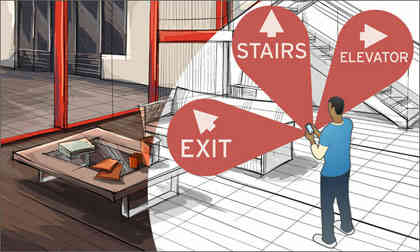| UnLoc - An App That Learns Where You Are Indoors |
| Written by Ian Elliot | |||
| Friday, 29 June 2012 | |||
|
How can you find your way around in a big building? You can't use GPS because reception is bad. Why not simply use an app that picks up invisible landmarks to determine where you are. We have all become used to GPS helping us find out where we are in the great big outdoor scheme of things, but it isn't much use once you get inside a building. For one thing, there usually isn't a signal and for another indoor navigation usually requires finer positioning. Now a team of researchers at Duke University, together with others from the Egypt-Japan University of Science and Technology, led by Romit Roy Choudhury, has applied some of the positioning techniques used by robots to build an app, called UnLoc, that learns where you are indoors.
It makes use of the sensors available on a mobile phone to recognize locations. For example as you move around the strength of the WiFi signal changes in fairly repeatable ways. There are specific motion signatures that can be picked up from the accelerometer such as traveling in a lift or even walking up stairs.
These all contribute to provide invisible landmarks which the app learns. Once it has identified a landmark it can then use the internal motion sensors to dead reckon the current position. Obviously when another invisible landmark is encountered it updates the position and corrects for any drift that has occurred. It is claimed that acuracies of around 1m are possible using the compase and gyroscope together for dead reckoning and land marks to correct position and orientation.
Test building with landmarks plotted
When the app is first loaded it is blank and has to learn the invisible landmarks for a particular location. This means that it becomes more accurate over time. Obviously pre-learned landmark maps could be downloaded for visits to new buildings, helping visitors to find their way in hospitals or shopping malls. As a spin off it needs less battery power than using GPS and, of course, used with GPS it is potentially much more accurate. Read the full paper if you want to know about the details of how the information was obtained from the lower quality sensors found in mobile phones and on how the sensors could be used together to correct problems inherent in each one. More InformationUnsupervised Indoor Localization pdf Related ArticlesGPS spoofing the new game in town
Comments
or email your comment to: comments@i-programmer.info To be informed about new articles on I Programmer, install the I Programmer Toolbar, subscribe to the RSS feed, follow us on, Twitter, Facebook, Google+ or Linkedin, or sign up for our weekly newsletter.
|
|||
| Last Updated ( Wednesday, 04 July 2012 ) |





